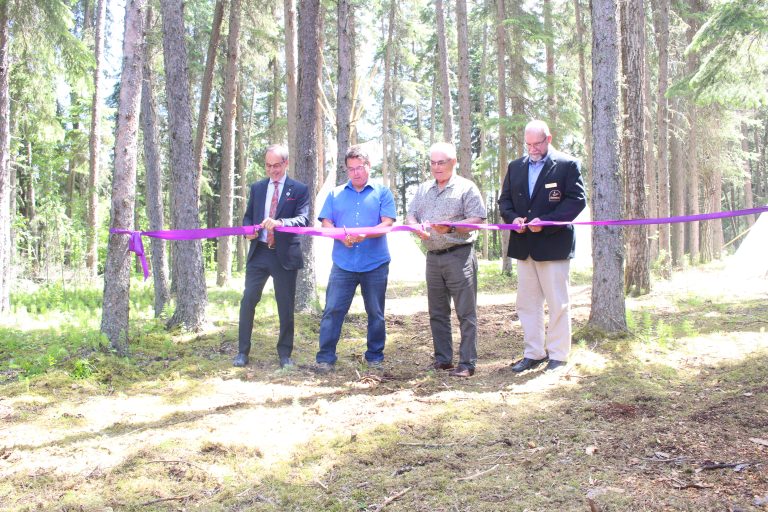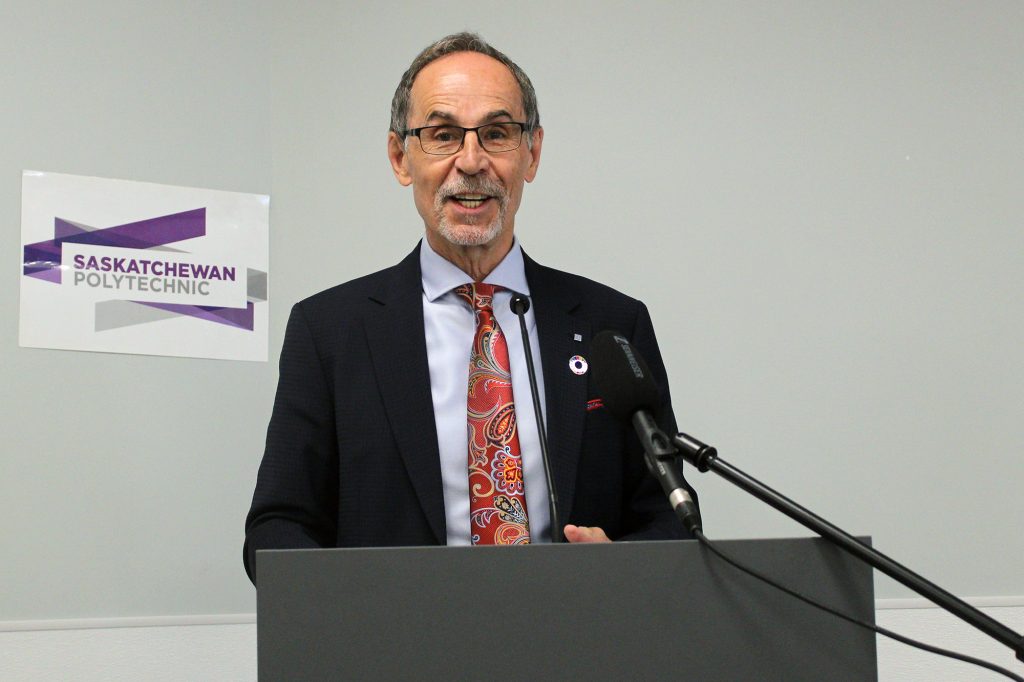
A new encampment nestled in the boreal forest north of Prince Albert will focus on land-based education.
The Prince Albert Grand Council (PAGC), Saskatchewan Wildlife Federation (SWF) and Saskatchewan Polytechnic held the official grand opening for the new Indigenous Outdoor Learning Centre on Thursday.
The centre is an extension of the Hannin Creek Education and Applied Research Centre (HCEARC) near Candle Lake. The three groups have spent the last 10 month collaborating on the project.
“At Saskatchewan Polytech we are all about applied hands on learning and a facility like this really allows us to have that hands-on experience for our learners,” Sask. Polytech president and CEO Larry Rosia said.
“They get to spend time and experience the land, living off the land and the opportunity to partner and have access to over 50 years of flora, fauna and wildlife data that exists in a Boreal Forest of Saskatchewan.”
Four tipis were raised on June 15 for the new Indigenous Outdoor Learning Centre.
The centre is called mitho askiy kiskēyihtamowin, which is Cree for good learning through experiences on the land.
Rosia said the centre provides a unique opportunity for students.
“For a number of them it’s a life changing experience,” he explained. “They have never had the opportunity to spend time outdoors in the wildlife.”

Rosia said in a press release that the project was an exciting collaboration that will focus on land-based learning while providing cultural awareness, training, and education about the ways and history of Indigenous people.
He added that everyone is on the same path, but it just takes different ideas to get there.
“With the Prince Albert Grand Council join now it’s the three prongs of the stool that puts it all together,” he explained. “It’s land based as well as the water here, and we do a lot of applied research with the water.”
Earlier in June, five Knowledge Keepers from Wahpeton Dakota First Nation shared their tipi knowledge with Sask Polytech and SWF. This included tipi history, protocols and the more practical aspect of how to raise one.
The tipis are an important part of the new encampment and will be used in land-based education for a range of learners.
Rosia added that it was all about the path to Truth and Reconciliation
SWF President David Yorke said the partnership dates back to a 2011 Memorandum of Understanding (MOU) between the organizations.
“We were looking at being able to expand to include everyone and this is just another one of the steps in that process,” Yorke said. “Sask Polytechnic is certainly very instrumental in doing that, in working through it, and the Saskatchewan Wildlife Federation has been very happy to have been able to work alongside them. It’s fantastic to have this day.”
The location was originally owned by the Kelsey Alumni Association, but Yorke said they needed to expand and upgrade the nearby facilities if they wanted a conservation camp there.
Ed Mirasty Director of Education for PAGC said the discussions to join the project began between Grand Chief Brian Hardlotte and Sask Polytech. These discussions led to a land based component of the curriculum.
Mirasty said they were pleased with the new camp, and hopeful it would provide peace and tranquility along with education.
“When you come to a place like this, Hannin Creek, it does lend itself to the concept of the land is healing,” he explained. “For Indigenous peoples, this is where you begin the healing aspect, the mental wellness. You return back to the grassroots.”
Mirasty said the program will teach students to live in harmony with the land from qualified instructors who will lead the training. He added that the PAGC mission statement makes programs like this a priority, so they were eager to take part.
“This is one way of showing a respect and appreciation for our culture,” he said. “This is the homeland and a lot of hunting territories in and around this area.”
Mirasty also honoured the centre and event with a prayer. Grand Chief Brian Hardlotte was not available for a speech, but Facetimed into the event along with Vice Chief Joseph Tsannie.
Speeches were also done by Rosia and Yorke. Interim Dean of the School of Mining, Energy and Manufacturing Brenda Suru also spoke before the ribbon cutting ceremony.
“Part of the Truth and Reconciliation calls to action is for institutions to Indigenize, so that’s part of the goal that we are doing,” Mirasty said.
He added that earlier there had been a Talking Circle of Residential School Survivors at the site, which has been used to develop curriculum and children’s books.
The facility was originally the vision of the late Jamie Hilts, the former Dean of the School of Mining, Energy and Manufacturing, who passed away last week. Hilts and his contributions were in everyone’s thoughts on Thursday.
“(I’m) just so happy to see people here,” Yorke said. “It would have been absolutely fantastic to enjoy this with Jamie Hlilts here. He was instrumental in so much of it, I know he is here and I know he is smiling. It was fantastic working with him on the committee.”
Rosia said Hilts’ vision got everyone excited, and helped drive the partnership with the SWF.
“At that time the park was in need of some work,” Rosia remembered. “He really had the vision for it, and actually drew it out on a bit of a piece of paper.”
The tipis for the mitho askiy kiskēyihtamowin Indigenous Outdoor Learning Centre are positioned almost exactly where Hilts envisioned them.
“My heart is still feeling sorrow for Jamie,” Rosia added. “I wish he would have been able to see his dream come true. As Brenda pointed out in her remarks, she has shown him pictures so he knew his dream was coming true. I know he is here with us today and he will be with us forever.”
An important part for everyone was to hold the grand opening as Indigenous People’s Month concluded.
The mitho askiy kiskēyihtamowin Indigenous Outdoor Learning Centre is based on the principles of miyo wâhkôhtowin (good relationships).
The HCEARC is located on Hannin Creek in Treaty 6 Territory and homeland of the Métis, situated in the boreal forest on the shores of Candle Lake, north of Prince Albert, Saskatchewan. HCEARC is managed by the SWF.
To book the mitho askiy kiskēyihtamowin Indigenous Outdoor Learning Centre please visit hannincreekcamp.org.
